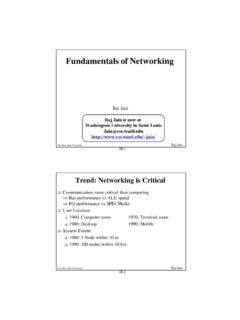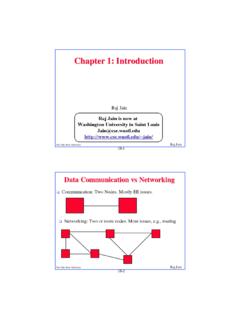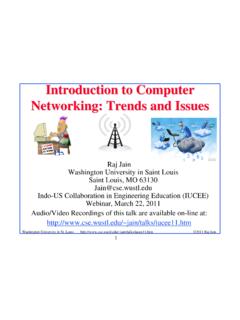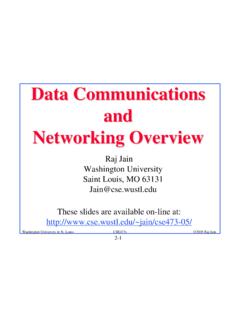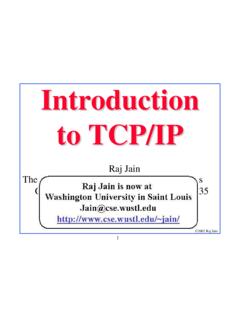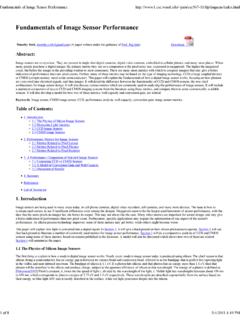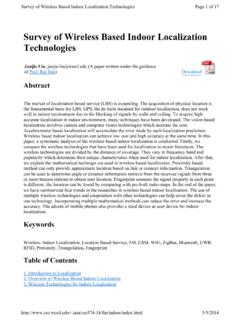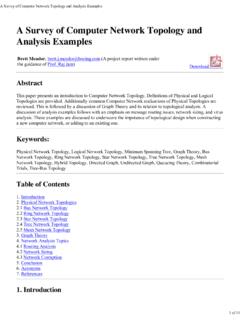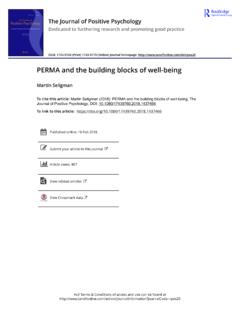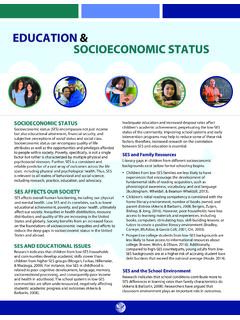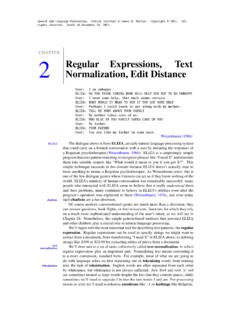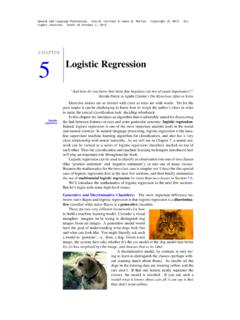Transcription of Introduction to Cellular Networks: 1G/2G/3G
1 Introduction to Cellular Networks: 1G/2G/3G . Raj Jain Washington University in Saint Louis Saint Louis, MO 63130. Audio/Video recordings of this class lecture are available at: ~jain/cse574-16/. Washington University in St. Louis ~jain/cse574-16/ 2016 Raj Jain 15-1. Overview 1. Cellular Telephony 2. Cellular Frequency Reuse 3. 2G: GSM. 4. : GPRS, EDGE. 5. 3G: W-CDMA. 6. : High-Speed Packet Access (HSPA). Note: technologies LTE and LTE Advanced discussed in future lectures of this class. Washington University in St. Louis ~jain/cse574-16/ 2016 Raj Jain 15-2. Cellular Network Beginnings AT&T Bell Labs designed a Cellular structure to reuse frequency. No two adjacent cells use the same frequency. 1977: FCC authorized two commercial deployments Chicago: Illinois Bell Washington, DC: American Radio telephone Service Both services started 1983. 6 2 7 7. 1 6 2 7 6 2. 5 3 1 6 2 1. 4 5 3 1 5 3. 7 4 5 3 4. 6 2 7 4 7. 1 6 2 6 2. Ref: P. Bedell, Cellular Networks: Design and Operation, A real World Perspective, Outskirts Press, 2014, ISBN:9781478732082.
2 Washington University in St. Louis ~jain/cse574-16/ 2016 Raj Jain 15-3. Initial Cellular System in US. US was divided into 306 metropolitan service areas (MSAs). 75% of US population, 20% of area Densely populated Small cell size 428 rural service areas (RSAs). Less populated Larger cell size Each area was originally allowed two competing carriers: A, B. Bell (B). Alternative (A). 832 channel-pairs in each area. 416 pairs per carrier. 45 MHz between transmit and receive frequencies 30 kHz per channel 1:7 Frequency reuse with hexagonal cells Too many applicants FCC started a lottery system At least one system in every market by 1990. Washington University in St. Louis ~jain/cse574-16/ 2016 Raj Jain 15-4. Cell Sites On towers, roof tops, water tanks, utility poles, . Good source of income for utility companies, cities, schools, churches, hotels, . With a base station for electronics NIMBY (Not in my back yard). Mostly hidden, shared towers Washington University in St.
3 Louis ~jain/cse574-16/ 2016 Raj Jain 15-5. Cells on Wheels (CoWs). Used for temporary surge in traffic, , games, fares, . Washington University in St. Louis ~jain/cse574-16/ 2016 Raj Jain 15-6. Macro, Micro, Pico, Femto Cells Macro: Sections of a city, more than 1 km radius Micro: Neighborhoods, less than 1 km Pico: Busy public areas: Malls, airports, , 200 m Femto: Inside a home, 10 m Ref: Washington University in St. Louis ~jain/cse574-16/ 2016 Raj Jain 15-7. Cellular Frequency Reuse Cluster Size =4 Cluster Size =7. Cluster Size =19. Washington University in St. Louis ~jain/cse574-16/ 2016 Raj Jain 15-8. Characterizing Frequency Reuse D = minimum distance between centers of cells that use the same band of frequencies (called co-channels). R = radius of a cell d = distance between centers of adjacent cells (d = R 3). N = number of cells in repetitious pattern (Cluster) R. Reuse factor d Each cell in pattern uses unique band of frequencies D.
4 Hexagonal cell pattern, following values of N possible N = I2 + J2 + (I x J), I, J = 0, 1, 2, 3, . Possible values of N are 1, 3, 4, 7, 9, 12, 13, 16, 19, 21, . Reuse Ratio = Distance/Radius = D/R= 3N. D/d = N. Ref: C. Siva Ram Murthy; B. S. Manoj, "Ad Hoc Wireless Networks Architectures and Protocols," Prentice Hall, 2004, ISBN: 013147023X, 880 pp., Safari Book, Section Washington University in St. Louis ~jain/cse574-16/ 2016 Raj Jain 15-9. Frequency Reuse Example What would be the minimum distance between the centers of two cells with the same band of frequencies if cell radius is 1 km and the reuse factor is 12? D/R = 3N. D = (3 12)1/2 1 km = 6 km Washington University in St. Louis ~jain/cse574-16/ 2016 Raj Jain 15-10. Homework 15A. The distance between cell centers with the same frequency band is required to be more than 6 km. What is the cell radius for the cluster size of 12. Washington University in St. Louis ~jain/cse574-16/ 2016 Raj Jain 15-11.
5 Frequency Reuse Notation N S K frequency reuse pattern N=Number of cells per cluster S= Number of sectors in a cell K = Number of frequency allocations per cell 1X3X3. Washington University in St. Louis ~jain/cse574-16/ 2016 Raj Jain 15-12. Frequency Reuse Notation (Cont). 1x3x1 1x3x3 1x1x1. 3x1x1 3x3x1 3x3x3. Washington University in St. Louis ~jain/cse574-16/ 2016 Raj Jain 15-13. Fractional Frequency Reuse Users close to the BS use all frequency subchannels Users at the cell boundary use only a fraction of available subchannels F1. F1,F2,F3. F2. F1,F2,F3. F3. F1,F2,F3. Washington University in St. Louis ~jain/cse574-16/ 2016 Raj Jain 15-14. Homework 15B. Label the frequency reuse patterns below. Washington University in St. Louis ~jain/cse574-16/ 2016 Raj Jain 15-15. Cellular Telephony Generations NA 3 GPP2. 1xEV 1xEV. AMPS cdmaOne CDMA2000 UMB. -DO -DV. NA-TDMA. 3 GPP2. D-AMPS. Evolved EDGE. Europe TACS GSM GPRS EDGE WCDMA HSPA+ LTE LTE-Adv 3 GPP.
6 China TD-SCDMA. Networking Industry Mobile WiMAX WiMAX2. Analog Digital CDMA OFDMA+ MIMO. FDMA TDMA. CDMA. Voice Voice Voice+Data Voice+Data Voice+HS Data All-IP. 1G 2G 3G 4G. Washington University in St. Louis ~jain/cse574-16/ 2016 Raj Jain 15-16. Cellular Generations (Cont). 1G: Analog Voice. FDMA. 1980s AMPS: Advanced Mobile Phone System TACS: Total Access Communications System 2G: Digital Voice. TDMA. 1990. cdmaOne: Qualcomm. International Standard IS-95. NA-TDMA. Digital AMPS (D-AMPS). GSM: Global System for Mobile Communications : Voice + Data. 1995. 1xEV-DO: Evolution Data Optimized 1xEV-DV: Evolution Data and Voice General Packet Radio Service (GPRS). Enhanced Data Rate for GSM Evolution (EDGE). Washington University in St. Louis ~jain/cse574-16/ 2016 Raj Jain 15-17. Cellular Generations (Cont). 3G: Voice + High-speed data. All CDMA. 2000. CDMA2000: Qualcomm. International Standard IS-2000. W-CDMA: Wideband CDMA. TD-SCDMA: Time Division Synchronous Code Division Multiple Access (Chinese 3G).
7 384 kbps to 2 Mbps : Voice + Higher-speed data EDGE Evolution High-Speed Packet Access (HSPA). Evolved HSPA (HSPA+). Ultra Mobile Broadband (UMB). Washington University in St. Louis ~jain/cse574-16/ 2016 Raj Jain 15-18. Cellular Generations (Cont). Two Tracks for 1G/2G/3G : Europe 3 GPP (3rd Generation Partnership Project). North America 3 GPP2. : High-Speed Data. VOIP. OFDMA. WiMAX 16e (Worldwide Interoperability for Microwave Access). Long Term Evolution (LTE). 4G: Very High-Speed Data. 2013. WiMAX 16m or WiMAX2. LTE-Advanced 100 Mbps 1 Gbps 5G: Ultra High-Speed Data. 2020. IP based Washington University in St. Louis ~jain/cse574-16/ 2016 Raj Jain 15-19. vs. 4G. 3G = International Mobile Communications 2000. (IMT-2000) = W-CDMA, CDMA2000. 4G = IMT-Advanced = LTE-Advanced, IEEE WiMAX forum officially declared WiMAX to be 3G. technology so that they can use spectrum allocated to 3G. WiMAX, LTE are at most or near-4G . Some telecom companies are selling them as 4G.
8 Washington University in St. Louis ~jain/cse574-16/ 2016 Raj Jain 15-20. GSM. Global System for Mobile Communications Implemented in 90% of cell phones world-wide. 1990 Technology using Time-Division Multiple Access (TDMA) in stead of Frequency Division Multiple Access (FDMA) used in 1G. 850/900/1800/1900 MHz (quad-band). Subscriber Identity Module (SIM) card contained user data. User could use any phone with his/her SIM card Frequency Frequency U1 U1 U2 U3 U4 U5 U6 U7 U8 U1. U2 U9 U10 U11 U12 U13 U14 U15 U16 U9. U3 U17 U18 U19 U20 U21 U22 U23 U24 U17. U4 U25 U26 U27 U28 U29 U30 U31 U32 U25. Time Time (a) FDMA (B) TDMA. Washington University in St. Louis ~jain/cse574-16/ 2016 Raj Jain 15-21. GSM Cellular Architecture Base Home Visitor Station Location Location Base Register Register Controller Transceiver Station Public Subscriber Base Mobile services Switched Identity Station Switching Telephone Module Controller Center Network Mobile Base Equipment Equipment Authenti- Transceiver Identity cation Station Register Center Mobile Station Base Station Subsystem Network Subsystem Radio Access Network Washington University in St.
9 Louis ~jain/cse574-16/ 2016 Raj Jain 15-22. Cellular Architecture (Cont). One Base transceiver station (BTS) per cell. One Base Station Controller (BSC) can control multiple BTSes. Allocates radio channels among BTSs. Manages call handoffs between BTSs. Controls handset power levels Mobile Switching Center (MSC) connects to PSTN and switches calls between BSCs. Provides mobile registration, location, authentication. Contains Equipment Identity Register. BTS BSC MSC MSC BSC BTS. VLR HLR. Washington University in St. Louis ~jain/cse574-16/ 2016 Raj Jain 15-23. Cellular Architecture (Cont). Home Location Register (HLR) and Visitor Location Register (VLR) provide call routing and roaming VLR+HLR+MSC functions are generally in one equipment Equipment Identity Register (EIR) contains a list of all valid mobiles. Authentication Center (AuC) stores the secret keys of all SIM. cards. Each handset has a International Mobile Equipment Identity (IMEI) number.
10 Washington University in St. Louis ~jain/cse574-16/ 2016 Raj Jain 15-24. GSM Radio Link Slow Associated Control Traffic Channel (SACCH) Traffic Channels Channels Unused Multiframe 0 1 2 10 11 12 13 14 23 24 25. 120 ms Burst Burst Burst Burst Burst Burst Burst Burst TDMA. Period Period Period Period Period Period Period Period Frame Preamble Well Known Pattern 120/26 ms Tail Data Stealing Training Stealing Data Tail Guard Burst Bits Bits Bits Sequence Bits Bits Bits Bits 15/26 ms 3 57 1 26 1 57 3 bits Ref: Martin Sauter, "From GSM to LTE-Advanced: An Introduction to Mobile Networks and Mobile Broadband, Revised Second Edition," John Wiley & Sons, August 2014, 456 pp., ISBN:978-1-118-86195-0 (Safari Book). Washington University in St. Louis ~jain/cse574-16/ 2016 Raj Jain 15-25. GSM Radio Link (Cont). 890-915 MHz uplink, 935-960 MHz downlink 25 MHz 125 200kHz frequency channels Each frequency channel is TDMA with burst (slot) period of 15/26 ms.
